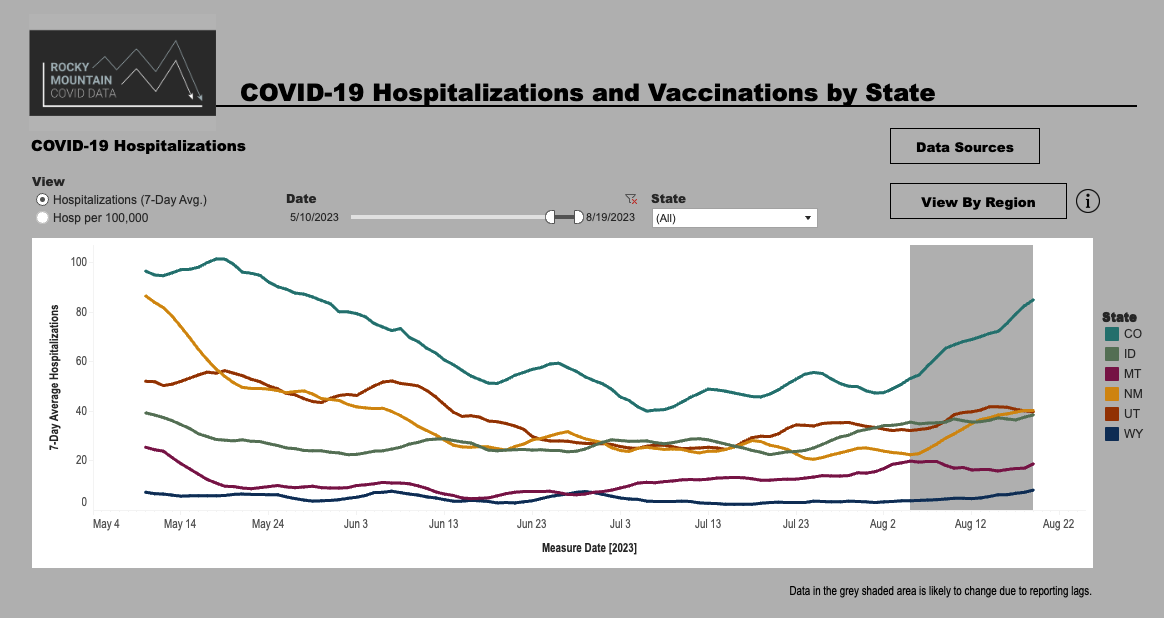What a rise in COVID hospitalizations and new variants might mean for fall
COVID-19 hospital demand has begun to rise in most states in the Rocky Mountain West. (https://rockymountaincoviddata.org/covid-19-surveillance)
COVID-19 hospitalizations are rising from all-time lows.
This summer, we have seen COVID-19 hospital demand drop to all-time lows, but that number is now rising in the Rocky Mountain West and nationwide. While the number of patients currently hospitalized with COVID-19 remains low in the Rocky Mountain West, COVID-19 hospital demand is rising, particularly in the more populous states of the region like Colorado, New Mexico, and Utah. COVID-19 hospitalizations in Montana have been increasing since early July.
COVID-19 hospital demand is rising in the three largest metropolitan areas including the Albuquerque (yellow line), Denver (teal line), and Salt Lake City (orange line) metropolitan regions. (https://rockymountaincoviddata.org/covid-19-surveillance)
Across the nation, counts of patients hospitalized with COVID-19 have increased too, as well as deaths due to COVID-19, test positivity, and wastewater trends.
The start of a fall wave?
It is possible this marks the start of an anticipated fall increase in COVID-19. Models project that COVID-19 hospital demand will peak in November or December in the United States in coming years, with the lowest levels of COVID-19 seen in late summer (COVID Scenario Modeling Hub).
The Eris variant grows.
This increase is COVID-19 believed to be due, in part, to one of the newest Omicron subvariants, EG.5, known as Eris, which is now the dominant variant in the United States, accounting for roughly 20% of new infections nationwide, and identified in over 50 countries. EG.5 was first reported in early 2023 and was designated as a variant under monitoring (VUM) this summer by the World Health Organization (WHO). EG.5 is descended from XBB.1.9.2, and likely has a growth advantage, meaning it spreads more rapidly than other variants, and immune escape properties. However, there is no evidence that EG.5 causes more severe disease. The WHO stated in an initial risk evaluation that “the public health risk posed by EG.5 is evaluated as low at the global level.” A preprint by Kaku et al. points to the possibility of EG.5.1, one of the most dominant subvariants of EG.5, having a higher effective reproduction number than XBB.1.5, XBB.1.16, and its parental lineage, XBB.1.9.2, “suggesting that EG.5.1 will spread globally and outcompete these XBB subvariants in the near future” (Kaku et al., 2023). For information on EG.5 and other variants in the Rocky Mountain West, please visit our Variant Information page.
Eris (EG.5) is one of the many subvariants to have branched off from the previous generation of Omicron variants.
A new variant on the horizon.
Recently, a new Omicron variant, BA.2.86, has been detected in limited numbers across the world. This variant has a large number of mutations relative to currently circulating variants. CDC describes the difference as akin to the difference between the initial Omicron variant (BA.1) and the Delta variant (BA.1.617.2). WHO classified this as a variant under surveillance on August 17. Due to the limited number of cases detected, variant characteristics such as growth advantage, immune escape and severity are currently unknown. We expect an updated assessment of the risks of this new variant in the weeks ahead.
What does this mean for fall boosters?
The US Food & Drug Administration (FDA) and vaccine manufacturers are gearing up for the release of updated COVID-19 vaccines in late September. These updated boosters are designed to target XBB.1.5, a variant that widely circulated in the US in summer 2023. While EG.5 and XBB.1.5 are not exactly alike, a vaccine against XBB.1.5 would still be more effective against EG.5 than the current bivalent boosters, which have half of their components from genetic material from the ancestral SARS-CoV-2 strain and the other half from genetic material shared by the Omicron BA.4 and BA.5 strains. Moderna recently announced that their updated COVID-19 vaccine produced a robust immune response against EG.5 and another variant, FL.1.5.1—a cousin of EG.5 that has also been gaining traction in the US in recent weeks. In places like the Rocky Mountain West, where vaccination coverage is heterogenous and uptake has been mixed across the regions and age groups, continued communication on the importance of updated boosters, and who should receive them, will be important as we enter into fall.
Stay knowledgeable,
The Team at Rocky Mountain COVID Data



